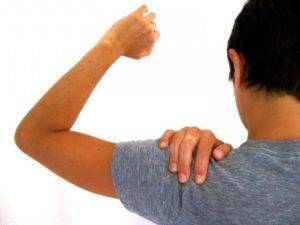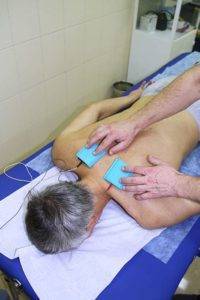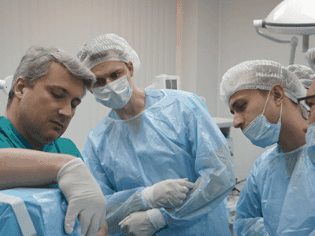
Currently, according to medical statistics, almost everyone over the age of 25-30 complains of cervical osteochondrosis symptoms. The disease strikes parts of the spine more often than others. Pathology is a progressive degenerative process that affects the intervertebral discs and vertebrae located in the neck. The disease is similar in men and women.
This is a dangerous and complex form of osteochondrosis, as there are large blood vessels in the neck that supply the brain and a large number of nerve endings. Disruption of preservation and blood flow causes a deterioration in the supply of oxygen and nutrients to the brain.
Signs of Disease
Symptoms of cervical osteochondrosis are more pronounced than in other parts of the spinal space, even with minor injuries. This is due to the fact that the spine in the neck is located close to each other, and the intervertebral disc has a low elevation. These anatomical features contribute to the fact that with osteochondrosis, nerve endings, spinal cord, and blood vessels are more often compressed.
General symptoms:
- pain syndrome;
- weakness and decreased sensitivity of the upper limbs;
- neck movement restrictions;
- impaired movement coordination;
- frequent dizziness;
- general weakness;
- deterioration of perceptual organ function (hearing, sight, touch, taste).

Pain is more common in the neck, radiating to the back of the head, shoulders, arms. The upper limb is in pain if the nerve root responsible for giving birth is pinched by a damaged vertebra. Pain in the back of the head is caused by spastic contraction of the neck muscles attached to the occipital bone, and circulatory disorders in this area.
Weakness of the arm is observed in patients if nerve roots are involved in pathological processes, which provide maintenance of the upper extremity muscle structure.
Limited mobility and characteristic fractures when twisting or tilting the neck occur if bone growth appears in the cervical vertebrae, the height of the intervertebral disc decreases, and the joints located between the vertebrae are affected.
The vertebrae in the neck have a transverse process that forms the channels through which the arteries that feed the brain run. With osteochondrosis of the cervical spine, the vertebrae are moved, connective tissue grows on it. This causes compression of the cervical artery, deterioration of blood supply to the brain and spinal cord. As a result, a person often experiences dizziness, movement coordination disorders, and general weakness. In further cases, if the arteries are involved in a pathological process or pinch vigorously, then the blood supply to the cerebellum, occipital portion and brain stem is significantly reduced. In this case, the function of the auditory organs, decreased vision, numbness of the tongue and fingers were observed.
The symptoms of the disease also depend on which of the eight vertebrae are affected by the degenerative or inflammatory process. Disorders of sensitivity and movement are caused by damage to the roots of the spine, which is affected by certain vertebrae. Depending on this, the following manifestations of cervical osteochondrosis are observed:
- first vertebra - the neck and occipital parts of the head become numb, sensitivity decreases;
- second - there is pain in the crown and occiput area;
- third - felt pain and decreased sensitivity in the part of the neck where the spinal cord is compressed, the intensity of sensation decreases, speech disorders occur; Fourth
- - painful sensation radiating to the shoulders, scapula, the patient is worried about heart disease, respiratory disorders, decreased neck muscle tone;
- fifth - pain is observed in the neck, given on the outer surface of the shoulder;
- sixth - pain in the neck radiating to the scapula, felt in the forearm and thumb;
- seventh - pain is given to the scapula, back of the shoulder, forearms and fingers (from the second to the fourth); Eighth
- - pain spreading from neck to shoulders, forearms and little fingers.
There are four degrees of cervical osteochondrosis, depending on the degree of lesion. This is not the stage of the disease, but the severity of the symptoms, because of the extent of the pathological process, which vertebra is affected.
- In the first stage, clinical symptoms are absent or minimal. The patient complains of mild pain, exacerbated by head movements. Treatment initiated at this stage of the disease will be effective. However, people often ignore symptoms that worry or do not feel it, so they do not go to the doctor.
- Increased pathological processes intensify symptoms. In the second stage, the pain becomes more pronounced, given to the upper limbs, shoulder blades. At this stage in the process of degenerative processes, the height of the intervertebral disc decreases, as a result of which nerve fibers are pinched. This causes an increase in pain. The second stage of cervical spine osteochondrosis is characterized by the appearance of headaches, deterioration of well-being, and decreased performance.
- The third stage of cervical osteochondrosis is characterized by the formation of an intervertebral disc hernia. Neck mobility is limited, during palpation, the patient feels severe pain. With the spread of such pathological processes, the pain becomes persistent, radiating to the upper limbs. There is a feeling of tension in the muscles attached to the occipital bone. Patients complain of frequent dizziness, general weakness, numbness in the hands.
- The fourth stage of cervical osteochondrosis is diagnosed when the intervertebral disc is completely destroyed by a degenerative process. It is replaced by fibrous tissue, which leads to significant restriction of movement. Spinal nerves and blood vessels in the neck are affected. Such changes are characterized by a significant deterioration in blood supply to the cerebellum and the occipital parts of the brain. Oxygen starvation leads to impaired coordination of movements, hearing, vision, tongue numbness, and speech disorders.
Methods of treatment
A timely visit to the doctor when the first symptoms are alarming, discomfort in the neck, reactions from the nervous system appear will prevent the development of degenerative changes. Treatment of cervical osteochondrosis consists of a set of therapeutic steps. Among them:
- taking medication;
- urut;
- physiotherapy training;
- physiotherapy procedures.
Treatment is carried out at home and on an outpatient basis, under the supervision of a physician. In some cases, more radical methods may be needed, then the patient is hospitalized.
Drug therapy
For the treatment of cervical osteochondrosis, the following groups of drugs are used:
- nonsteroidal anti-inflammatory drugs;
- chondroprotectors;
- muscle relaxants;
- drugs that improve blood rheological parameters;
- Vitamin B
Doctors prescribe anti-inflammatory drugs to reduce pain intensity, reduce inflammation and swelling of nerve roots. Chondroprotectors restore damaged cartilage tissue in the intervertebral disc. Relax the muscles relax the neck muscles, relieve cramps. Medications to increase blood flow help restore disturbed blood supply to the brain. Vitamin B activates metabolism in nerve tissue. With severe pain, the doctor may prescribe analgesic medication. If the patient has severe pain syndrome, then analgesics are given parenterally, after the pain subsides, they switch to pills.
In addition to pharmaceutical drugs, patients can use traditional methods to treat cervical osteochondrosis. Before using it, you need to see a doctor so that there is no conflict between drugs and non-traditional methods. Decoction and infusion of dill seeds, hop cones, purple flowers help stop the inflammatory process and relieve pain.
Physiotherapy

Physiotherapy is an effective method of combating cervical spine osteochondrosis. It is very important to treat this disease by using such techniques, the results of which are achieved as follows:
- pain intensity decreases;
- activation of recovery of affected bone, cartilage and muscle tissue;
- Cramps and muscle tension relax;
- the inflammatory process is stopped;
- increases the delivery of oxygen and nutrients to the affected area and the brain.
The following types of procedures are considered most effective in the treatment of osteochondrosis:
- drug electrophoresis (electric current is applied to the affected area, which, in addition to activating blood flow and tissue recovery, increases the delivery of the active ingredient of the drug to tissues affected by degenerative processes);
- ultrasound therapy (metabolic processes in diseased areas are activated, pain is reduced, inflammation is stopped);
- magnetotherapy (relieves swelling of the affected area, which helps reduce pain intensity);
- laser therapy (improves blood circulation in areas of pathological processes, has anti-inflammatory effect).
Also, doctors can advise acupuncture, balneology procedures.
Physiotherapy training
Exercise is prescribed during the period when the acute manifestations of the disease are stopped. During gymnastics, there is no discomfort and pain.

This complex should be performed after reaching a stable level of remission to prevent relapse.
- Take a prone position, lift your head and body, leaning on your hands. The back is straight, breathing deeply and evenly. Hold the position for a minute or two, then slowly take the starting position. The number of repetitions is 3.
- Position - lying on the abdomen, arms along the body. Slowly turn your head, trying to touch your ear to the floor. Repeat 6 times on each side.
- Sit or stand, tilt your head while inhaling, trying to reach your chest with your chin. As you exhale, slowly pull your head back, raising your eyes to the ceiling. The number of repetitions is 10-15.
- A good exercise to strengthen the neck muscles is to press the forehead to your hands. To achieve the effect, you need to press with the palm of your hand on the forehead and the forehead on the palm of your hand for 30 seconds. Repeat three times.
- Rotate your head in a circle. Exercise should be done slowly, smoothly. In each direction - 10 turns. The occurrence of dizziness while performing movements is unacceptable. If this happens, you should stop immediately.
All exercises must be performed smoothly, without sudden movements, in case of deteriorating health, the appearance of nausea, dizziness, immediate cessation.
Sort

This course is prescribed by a doctor in the absence of acute pain, can only be done by a specialist with medical education. With such a disease, it is not recommended to contact non-professionals.
Neck Massage Healing Effects:
- increases blood and lymph flow in the affected area;
- muscles relax, cramps relieve;
- the intensity of the painful sensation decreases.
Experts use the whole range of massage movements: caressing, rubbing, kneading, squeezing and vibrating.
Surgery
Surgery is indicated if conservative therapy does not bring results within six months, the patient experiences severe pain, signs of damage to nerve fibers and myelopathy are observed. If osteochondrosis of the cervical spine is complicated, there is a threat of stroke, there is strong compression of the spinal cord, then surgery is necessary.
According to the instructions, the following types of surgical interventions are used:
- endoscopic discectomy - removal of part or all of the intervertebral disc;
- laminotomy - amputation of bone ligaments and excessive bone tissue particles (often combined with laminoplasty - installation of artificial plates to expand spinal canals);
- disc nucleus vaporization - splits the intervertebral disc nucleus with a laser beam simultaneously with the destruction of its destroyed fragments;
- Cold plasma nucleoplasty - instead of endoscopy, long and thin hollow needles are used, which are inserted into the intervertebral disc, where electrodes are sent to the lesion site, which has the effect of cold plasma.

The neck is a complex organ containing large blood vessels, the spinal cord. They are easily damaged, therefore, surgical intervention is performed no more than 5% of cases. Surgical treatment is often accompanied by the development of complications. Among them:
- inflammatory processes in the tissues or membranes of the spinal cord;
- osteomyelitis;
- scars that cause narrowing of arterial and spinal canals.
Surgery on the cervical spine is difficult and requires a long recovery period. Patient recovery after surgery takes six months or more.
Prevention
To prevent the development of cervical osteochondrosis, it is necessary to:
- monitor the position of the spine and neck;
- lead an active lifestyle, move more;
- while doing physical exercise, you must be careful, pay attention to proper implementation, because even minor injuries can affect the condition of the musculoskeletal system;
- maintain proper body position while sleeping, buy an orthopedic or anatomical mattress;
- complements workplaces properly where one spends a lot of time;
- frequently involved in physical education;
- monitor your diet, make sure the supply of all the essential minerals needed for strong bones, especially magnesium and calcium;
- regularly undergo dispensary examinations to detect osteochondrosis in a timely manner.
Prevention will help prevent degenerative changes in the cervical spine, protect against painful sensations, dizziness, limb numbness and other unpleasant symptoms.





































